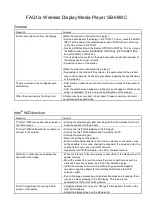
138
Glossary
App
endi
x
not be read correctly, depending on
the playback speed.
See also VITC.
Non-drop frame mode
In this mode, drop frame mode
processing is not performed. Since
there is no frame cutting, a
discrepancy of about 86 seconds
occurs each day (in the case of a field
frequency of 59.94 Hz) which causes
problems when editing programs in
units of seconds using the number of
frames as a refernce.
See also Drop frame mode.
Preroll
The rewinding of a video tape in the
player or recorder VTR by a certain
length before an edit point, allowing
the tape to attain a stable speed at the
edit point and synchronization with
the other video tape during editing.
Reference video signal
A video signal containing a sync
signal or sync and burst signal, used
as a reference for synchronizing
video equipment.
Servolocking
The locking of the phase and speed of
a VTR’s head drum rotation and tape
transport to a reference signal during
recording and playback.
Standby-off mode
A mode in which head drum rotation
is stopped and tape tension is
released, and thus the VTR is not
ready for immediate recording and
playback. This mode alleviates the
tape and video heads from wear or
damage.
An Standby-on mode
A mode in which the head drum
rotates with the tape wrapped around
it, and thus the VTR is ready for
immediate recording or playback.
The VTR enters standby-off mode
after remaining in standby-on mode
for a specified length of time to
prevent wear or damage to the tape
and video heads.
Time code
A digital signal recorded on the video
tape that supplies information such as
hour, minute, second and frame
number for each frame to facilitate
the setting of edit points or searching
for specific scenes on the tape.
There are two types of time codes:
SMPTE (for the NTSC color system)
and EBU (for the PAL/SECAM color
system); and two time code recording
formats: LTC (longitudinal time
codes) which are CTL signals and
audio signals simultaneously
recorded longitudinally on the tape
and VITC (vertical interval time
codes) which are recorded on the
video signal track.
Tracking
The synchronizing of the head drum
rotation phase and tape transport
phase during playback and recording.
Tracking is adjusted to eliminate
picture instability when playing back
material recorded on another VTR.
User bits
A recordable 32-bit section in each
time code on a video tape for
recording such information as the
recording year, month, and day, and
the tape or program ID number.
Vertical interval time code
VITC
Abbreviation for Vertical Interval
Time Code. This is a time code
recorded on a video signal track
during the vertical blanking interval.
This VTR writes this time code in the
AUX data area in the video signals. It
can be read correctly even during
slow or still picture playback.
See also LTC.
















































